NVIDIA GeForce GTX 690 Review: Ultra Expensive, Ultra Rare, Ultra Fast
by Ryan Smith on May 3, 2012 9:00 AM ESTOverclocked: Power, Temperature, & Noise
Our final task is our look at GTX 690’s overclocking capabilities. NVIDIA has told us that with GTX 690 they weren’t just looking to duplicate GTX 680 SLI’s performance, but also its overclocking capabilities. This is quite the lofty goal, since with GTX 690 NVIDIA is effectively packing 2 680s into the same amount of space, leaving far less space for VRM circuitry and trace routing.
| GeForce 600 Series Overclocking | ||||
| GTX 690 | GTX 680 | |||
| Shipping Core Clock | 915MHz | 1006MHz | ||
| Shipping Max Boost Clock | 1058MHz | 1110MHz | ||
| Shipping Memory Clock | 6GHz | 6GHz | ||
| Shipping Max Boost Voltage | 1.175v | 1.175v | ||
| Overclock Core Clock | 1040MHz | 1106MHz | ||
| Overclock Max Boost Clock | 1183MHz | 1210MHz | ||
| Overclock Memory Clock | 7GHz | 6.5GHz | ||
| Overclock Max Boost Voltage | 1.175v | 1.175v | ||
In practice NVIDIA has not quite kept up with GTX 680, and in other ways completely exceeded it. When it comes to the core clock we didn’t quite reach parity with our reference GTX 680; the GTX 680’s highest boost clock bin could hit 1210MHz, while the GTX 690’s highest boost clock bin topped out at 1183MHz, some 27MHz (2%) slower.
On the other hand, our memory overclock is so high as to be within the “this doesn’t seem physically possible” range. As we have discussed time and time again, GDDR5 memory busses are difficult to run at high clocks on a good day, never mind a bad day. With GF110 NVIDIA couldn’t get too far past 4GHz, and even with GTX 680 NVIDIA was only shipping at 6GHz.
It would appear that no one has told NVIDIA’s engineers that 7GHz is supposed to be impossible, and as a result they’ve gone and done the unthinkable. Some of this is certainly down to the luck of the draw, but it doesn’t change the fact that our GTX 690 passed every last stability test we could throw at it at 7GHz. And what makes this particularly interesting is the difference between the GTX 680 and the GTX 690 – both are equipped with 6GHz GDDR5 RAM, but while the GTX 680 is equipped with Hynix the GTX 690 is equipped with Samsung. Perhaps the key to all of this is the Samsung RAM?
In any case, our final result was a +125MHz core clock offset and a +1000MHz memory clock offset, which translates into a base clock of 1040MHz, a max boost clock of 1183MHz, and a memory clock of 7GHz. This represents a 12%-14% core overclock and a 17% memory overclock, which is going to be enough to put quite the pep in the GTX 690’s step.
As always we’re going to start our look at overclocking in reverse, beginning with power, temperature, and noise. For the purpose of our testing we’ve tested our GTX 690 at two different settings: at stock clocks with the power target set to 135% (GTX 690 PT), and with our custom overclock alongside the same 135% power target (GTX 690 OC). This allows us to look at both full overclocking and the safer option of merely maxing out the boost clocks for all they’re worth.
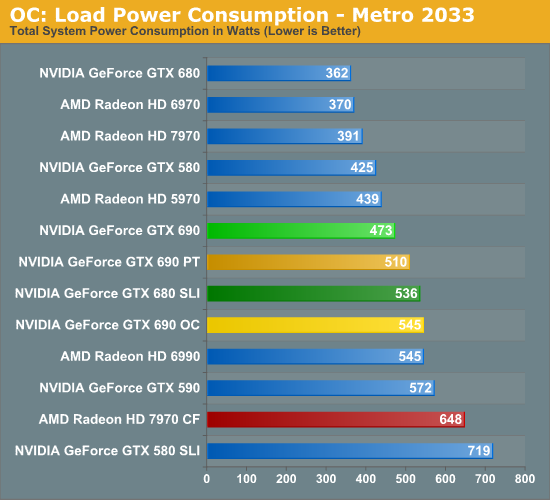

As expected, merely increasing the power target to 135% was enough to increase the GTX 690’s power consumption, though overclocking further adds to that. Even with the power target increase however, the power consumption at the wall for the GTX 690 is still lower than the GTX 680 SLI by over 20W, which is quite impressive. As we’ll see in our section on performance this is more than enough to erase the GTX 690’s performance gap, meaning at this point its still consuming less power than the GTX 680 SLI while offering better performance than its dual-card cousin.
It’s only after outright overclocking that we finally see power consumption equalize with the GTX 680 SLI. The overclocked GTX 690 is within 10W of the GTX 680 SLI, though as we’ll see the performance is notably higher.
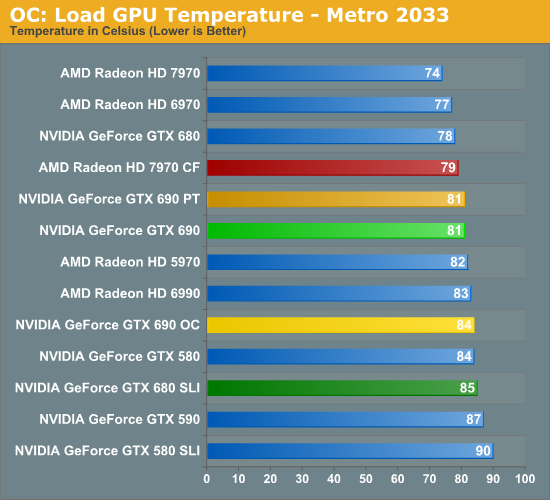
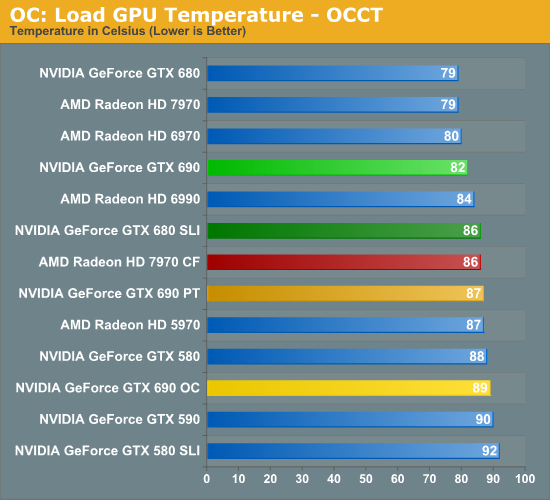
What does playing with clocks and the power target do to temperatures? The impact isn’t particularly bad, though we’re definitely reaching the highest temperatures we really want to hit. For the GTX 690 PT things are actually quite good under Metro, with the temperature not budging an inch even with the higher power consumption. Under OCCT however temperatures have risen 5C to 87C. Meanwhile the GTX 690 OC reaches 84C under Metro and a toasty 89C under Metro. These should be safe temperatures, but I would not want to cross 90C for any extended period of time.
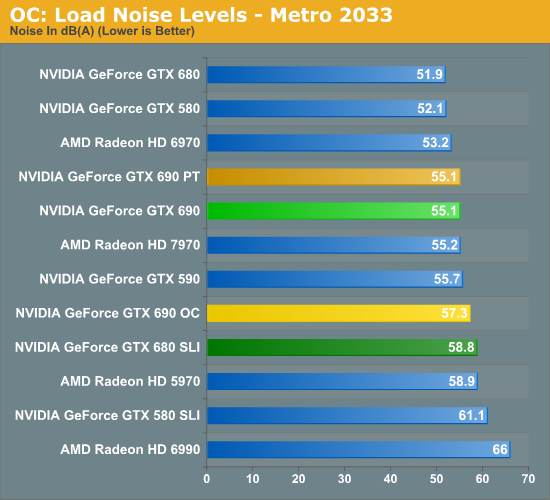
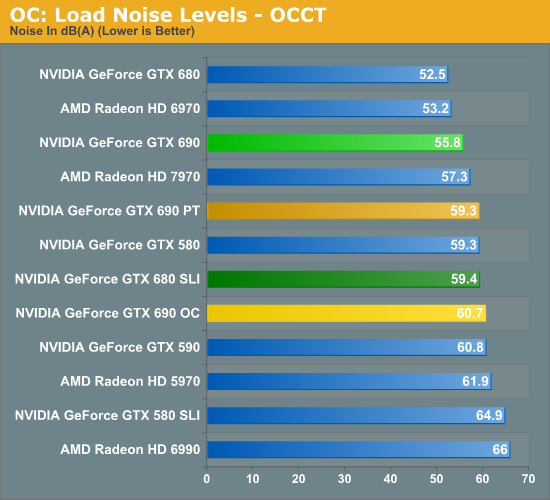
Finally we have load noise. Unsurprisingly, because load temperatures did not go up for the GTX 690 PT under Metro load noise has not gone up either. On the other hand load noise under OCCT has gone up 3.5dB, making the GTX 690 PT just as loud as our GTX 680 SLI in its adjacent configuration. In practice the noise impact from raising the power target is going trend closer to Metro than OCCT, but Metro is likely an overly optimistic scenario; there’s going to be at least a small increase in noise here.
The GTX 690 OC meanwhile approaches the noise level of the GTX 680 SLI under Metro, and shoots past it under OCCT. Considering the performance payoff some users will no doubt find this worth the noise, but it should be clear that overclocking like this means sacrificing the stock GTX 690’s quietness.










200 Comments
View All Comments
bobsmith1492 - Thursday, May 3, 2012 - link
It's not that rare; I got a fairly inexpensive 24" 1920x1200 HP monitor from Newegg a year ago. There weren't many options but it was there and it's great.a5cent - Thursday, May 3, 2012 - link
You are right that the average Joe doesn't have a 1920x1200 monitor, but this is an enthusiast web-site! Not a single enthusiast I know owns a 1080 display. 1920x1200 monitors aren't hard to find, but you will need to spend a tad more.CeriseCogburn - Saturday, May 5, 2012 - link
Nope, 242 vs 16 is availability, you lose miserably. You all didn't suddenly have one along with your "friends" you suddenly acquired and have memorized their monitor sizes instantly as well.ROFL - the lies are innumerable at this point.
UltraTech79 - Thursday, May 3, 2012 - link
They make up about 10% stock. I wouldn't call that very rare. Newegg and other places have a couple dozen+ to choose from.Maybe YOU dont buy very much.
CeriseCogburn - Tuesday, May 8, 2012 - link
Closer to 5% than it is to 10%, and they cost a lot more for all the moaning penny pinchers who've suddenly become flush.Digimonkey - Thursday, May 3, 2012 - link
It's either 1920x1200 @ 60hz, or 1920x1080 @ 120hz. I prefer smoother gameplay over 120 pixels. Also I know quite a few gamers that like using their TV for their PC gaming, so this would also be limited to 1080p.CeriseCogburn - Friday, May 4, 2012 - link
No one here is limited, they all said, so no one uses their big screens, they all want it @ 1200P now because amd loses not so badly there...ROFL
Dracusis - Thursday, May 3, 2012 - link
I'm be more worried about AMD's performance going down in certain games due to Crossfire than something as trival as this. As a 4870X2 owner I can tell you this is not at all uncommon for AMD. I still have to disable 1 GPU in most games, including BF3, because AMDs drivers for any card more than 12 months old are just terrible. As you can see even the 6990 is being beat by a 6970 in games as modern as Skyrim - their drivers are just full of fail.Galidou - Thursday, May 3, 2012 - link
A much higher percentage?!? that's 7% more... nothing extraordinary...Let's just say a higher percentage, when you say much, it makes us beleive Nvidia's paying you.CeriseCogburn - Saturday, May 5, 2012 - link
10% you might be able to ignore, 17% you cannot. It's much higher, it changes several of the games here as to who wins in the article in the accumulated benches.It's a big difference.